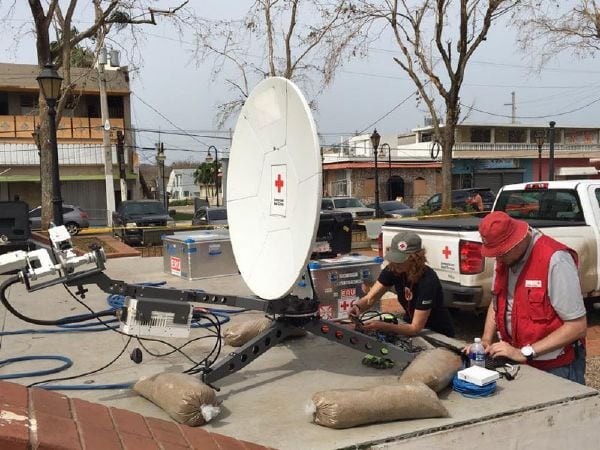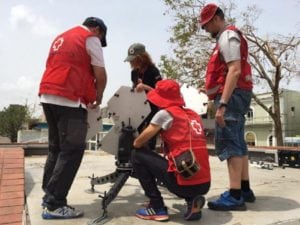Latest News

By setting up mobile VSATs, the Red Cross is helping Puerto Ricans reconnect with loved ones and access the internet. The technology also helps aid workers coordinate relief efforts on an island where infrastructure and telecommunications networks are badly damaged. Photo by Colin Chaperon for the American Red Cross on September 27, 2017.
Nearly a month after Hurricane Maria decimated Puerto Rico’s already frail infrastructure, 76 percent of total cell sites still remain out of service, according to the Federal Communications Commission (FCC). The U.S. government’s response to the situation, as well as comments made by President Trump, have been largely controversial — but organizations such as the American Red Cross state they have nonetheless made significant progress in reconnecting the island’s residents using satellite technology.
Colin Chaperon, international emergency field operations lead for the American Red Cross, told Via Satellite that the unprecedented scale of the disaster has allowed the organization to trial new technologies and services for its clients, including satellite. More specifically, the American Red Cross has worked to provide alternate means of connectivity for residents seeking to contact their loved ones and information from government officials.
“Wherever you drive, you see people in their cars on top of bridges or parked on the side of the road waiting to catch a signal. People are driving long distances just to park in certain areas where reception is available,” Chaperon said.
To help reconnect these residents, Chaperon said the American Red Cross has for the first time deployed roving units equipped with Very Small Aperture Terminals (VSATs). And although the service is limited to just two mobile teams, the organization has been able to supply free Wi-Fi in places most heavily impacted by the storm’s destruction.
“We try to reach the most inaccessible areas first. We also look at vulnerability — where can our services have the greatest impact? We continue to try to focus on areas that have not received assistance to date,” Chaperon said. “Once we go live with our signals they’re able to log onto the internet and reach families by Facebook Messenger and any other social media platform that they used pre-disaster.”
Chaperon described the relief effort as a “grassroots, low budget, high impact solution,” leveraging one 0.9-meter dish and another 1-meter dish connected via Ku-band capacity. Additionally, the generators that power the VSATs allow the organization to daisychain power strips to cobble together charging stations for residents’ mobile devices. “These are all airline checkable, very transportable modules,” Chaperon added.

The Spanish Red Cross and Finnish Red Cross helped the American Red Cross with this incredible project.
Photo by Colin Chaperon for the American Red Cross on September 27, 2017.
The more than 500 American Red Cross volunteers scattered throughout the island also use Iridium satellite phones and Very High Frequency (VHF) radios to communicate with each other and headquarters.
“Wherever we’re co-located with other teams providing other services, those folks are able to access that service and send reports back to headquarters and make their regular routine calls,” Chaperon said. “We’re away from our families for a month at a time in many cases, and we also take the opportunity to check in with our loved ones as well.”
In the modern era — where connectivity has become as vital a resource as food and water — the sudden vacuum of information has made logistics for federal officials a nightmare, Chaperon noted. “We’re so conditioned to getting information at our fingertips daily,” he said. “When there’s a void I can imagine how that might be paralyzing to a degree because we don’t have that information flow.”
Indeed, the situation has turned everyday tasks into almost insurmountable challenges for the island’s residents. “There was a lady at one of our sites that was so excited to be able to access our Wi-Fi, not necessarily because she was seeking her loved ones but because she wanted to pay her bills online,” Chaperon said. “She just wanted to make sure she was on time.”
According to Puerto Rican newspaper El Nuevo Dia, the U.S. Army Corps of Engineers has received a total of $577 million from the Federal Emergency Management Agency (FEMA) to help restore power to the island. Commercial operators too have begun to propose more creative means of reconnecting the population in the absence of functional cell towers. Alphabet, for example, intends to deploy stratospheric balloons from its Project Loon program to provide wireless communications. SpaceX CEO Elon Musk has also offered to rebuild the island’s infrastructure using a network of batteries and solar panels that operate separately from the established electricity grid. Challenged by questions about funding and coordination with government officials, how these proposals will ultimately play out remains to be seen.
During our interview, Chaperon said that he was struck by the emotional outpouring that he’s seen as a result of these relief efforts. “The tears of joy shed [from] being able to connect and reach people all over the continent U.S. makes all the stress of field conditions worth it because you know you’re bringing hope to people who have lost it during these trying times,” he said.
Get the latest Via Satellite news!
Subscribe Now